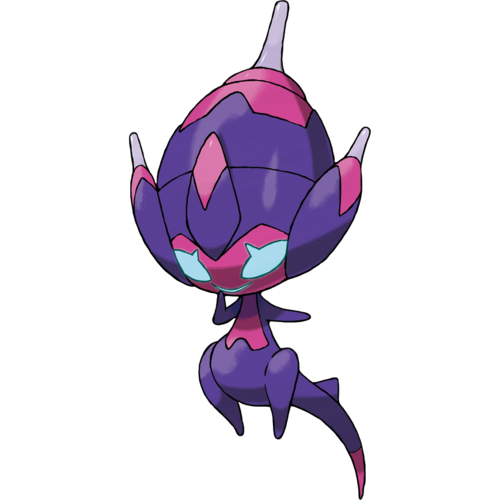
Finally, we’ve dealt with ALL the Ultra Beasts. Nihilego, Buzzwole, Pheromosa, Xurkitree, Celesteela, Kartana, Guzzlord, all seven of them have been reviewed.
…
…what do you mean, they added more!?
Okay, so… 802 Pokémon was not enough, it’s never enough, it will never be enough until I’m dead, so Ultra Sun and Ultra Moon added another five Pokémon that weren’t in the original Sun and Moon, and can’t be traded back to those games either. Four of those were additional Ultra Beasts, and for the sake of thematic unity I’m going to cover them before returning to the legendary Pokémon of Alola. Our subjects for today are the first two, the only Ultra Beasts to evolve: Poipole and Naganadel, the Poison Pin Pokémon (the same species name as Nidoran!).
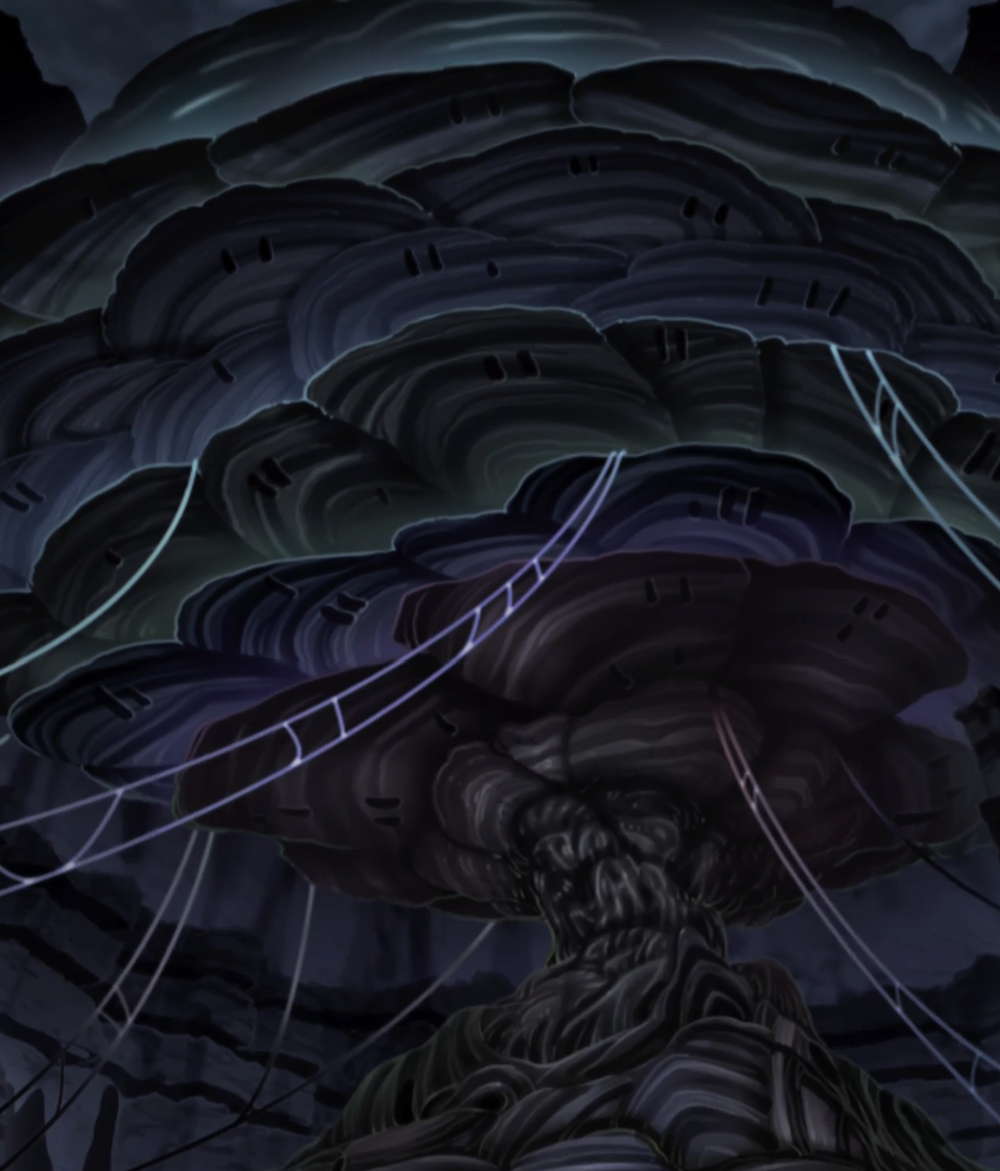
Poipole and Naganadel are poisonous Ultra Beasts with both reptilian and insectoid features, whose bodies are perhaps loosely based on syringes or hypodermic needles. They are equipped with stingers connected to large reservoirs of poisonous fluid with some interesting properties: it’s extremely sticky, hence Poipole’s codename UB Adhesive, it’s luminescent, and Naganadel can squirt it up to six miles (just under 10 km). In the anime, Ash has a Poipole for a while, and it can produce two colours of liquid, red and blue (although I don’t think we ever see them glow), which it delights in using to draw pictures that become increasingly elaborate over the time it spends in Alola. If all this is meant to be a reference to any specific adhesive compound from the real world, I can’t find it. Natural adhesives are common enough, though; many species of insects, molluscs, echinoderms and so on can secrete glue-like substances to anchor themselves or their eggs to a surface, and social insects like the paper wasp can build nests out of saliva and plant fibres. Some species of swiftlet bird even construct their nests completely out of adhesive saliva, without collecting any twigs or other materials at all. And, of course, Pokémon is already familiar with offensive uses of natural adhesives, because we have Pokémon based on spiders, whose webs are liberally studded with droplets of gluey glycoproteins that help to ensnare prey. In the anime we see a colony of Poipole, led by a single (queen?) Naganadel, living in a colossal, vaguely mushroom-shaped structure draped in strands resembling spider silk, with interior chambers that have hexagonal-patterned walls and luminescent needles hanging from the ceiling. It very much seems as though they live like social insects, and use their powerful adhesive secretions not only in combat, but to construct highly complex nests.
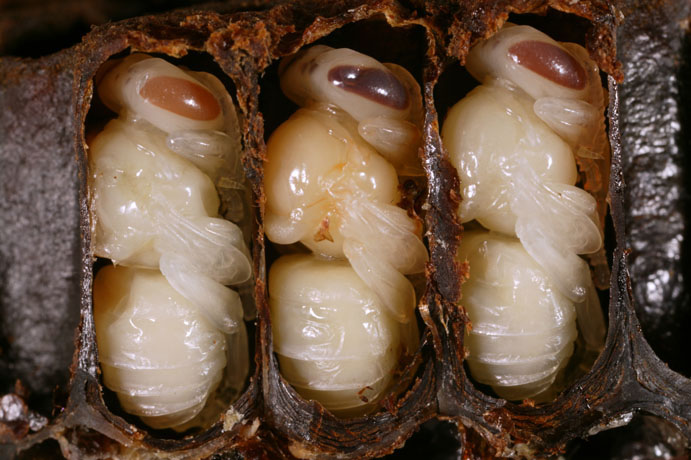
Poipole’s physical design has been confirmed to be partly inspired by a bee larva (I assume we’re thinking here of the pupal stage, where the shape of the bee’s adult anatomy is starting to become distinct), so the stingers, the venom, and the colony with an architecturally complex nest are all elements that make some thematic sense. The reasons for the adhesive and luminous properties are still elusive, but those both sound vaguely like properties that some complex biopolymer might have. Naganadel is clearly draconic, but also has a plump abdomen like a bee’s or wasp’s, as well as lots of stripes, angular shapes and spikes – to me it almost looks a little like a spaceship, playing into the sci-fi aesthetic that a lot of the Ultra Beasts share (especially Celesteela). Naganadel’s abdomen, with its three stingers, actually looks a lot like Poipole’s head, as if the Pokémon turned itself upside down when it evolved. This is in fact exactly what has happened: the Ultra Smoon website claims that Naganadel’s brain is in its abdomen, and is directly connected to its abdominal stingers, which makes them extremely sensitive. So… that means Naganadel’s poison… its adhesive, glowing poison that it can fire at a distance of six miles… is brain goo? Maybe that’s why it’s such a mess of different properties; it’s not just a poison, but a vital fluid that serves a range of purposes in Poipole and Naganadel’s bodies. For comparison, we could note that real insects don’t have blood; instead they have a blood-like plasma called haemolymph, which is usually blue-green because it carries oxygen using copper-based haemocyanin rather than iron-based haemoglobin (we could even speculate a purple manganese-based protein for Poipole – then again, note the blue glow of Poipole’s eyes and mouth). Moreover, if the brain is in the abdomen, then what seems to be Naganadel’s head should perhaps be understood, instead, as a kind of decoy. Enemies will instinctively target the head, thinking that it’s a weak spot, when actually it’s the dangerous stingers that are most vulnerable, packed with nerves and directly connected to the brain. This kind of strategy certainly has parallels in the real world. The hilariously named fluffy tit butterfly has hindwings that are patterned to look like a second head, while many species of butterflyfish have prominent eyespots towards the rear end of their dorsal fin. Either way, predators thinking that they’re aiming for the head might instead clip a part of the animal that it can live without.

According to the Ultra Smoon website, Poipole “displays many emotions” and is “said to be able to understand human speech,” which is not terribly impressive, considering that most Pokémon have a pretty wide emotional range, can at the very least understand commands, and generally seem to be capable of empathising with humans. I think the statement makes more sense, though, if we take it as something that is unusual for an Ultra Beast. The other Ultra Beasts are inscrutable to us, and we seem inscrutable to them; they didn’t coevolve with humans, the way Pokémon from our own world did, so they can neither understand humans instinctively nor express their own needs and desires in ways we can immediately process. For whatever reason, that isn’t true of Poipole, who takes to human companionship in much the same way as a terrestrial Pokémon. This could conceivably be because Poipole and Naganadel are familiar with humans already: they are apparently native to the world of Ultra Megalopolis, the high-tech city in Ultra Space where we confront Necrozma in Ultra Smoon. We obtain Poipole in the games after defeating Necrozma, when it is presented to us as a gift by members of the Ultra Recon Squad (a team of Ultra Megalopolitans who have been sent to Alola to study our world). According to the Ultra Sun Pokédex, Poipole is “well enough liked to be chosen as a first partner in its own world,” although when you first meet the Ultra Recon Squad it seems like the concept of Pokémon training is initially alien to them. They solve their problems with technology, not with the help of Pokémon, and are impressed by the novelty (to them) of the Alolans’ approach. They begin training a Poipole only during the course of the story, after apparently becoming frustrated in their attempts to train a Furfrou that they caught Alola. It’s possible that the Pokédex’s assessment reflects Poipole’s status after the events of the game, when the Ultra Recon Squad has learned about Pokémon training from the Alolans and brought those lessons back to their own world. Poipole itself still has those traits that seem to stem from a longer history with humans, though. To launch ourselves briefly into the realm of speculation, I’d like to suggest that Poipole evolved on a world where humans once trained Pokémon, but no longer do. The lost light of Necrozma is a power that (in Alola, anyway) humans share with Pokémon, so maybe the ancestors of the people of Ultra Megalopolis lost their ability to train Pokémon, including Poipole, when their world became dark. Only now are they beginning to recover it.
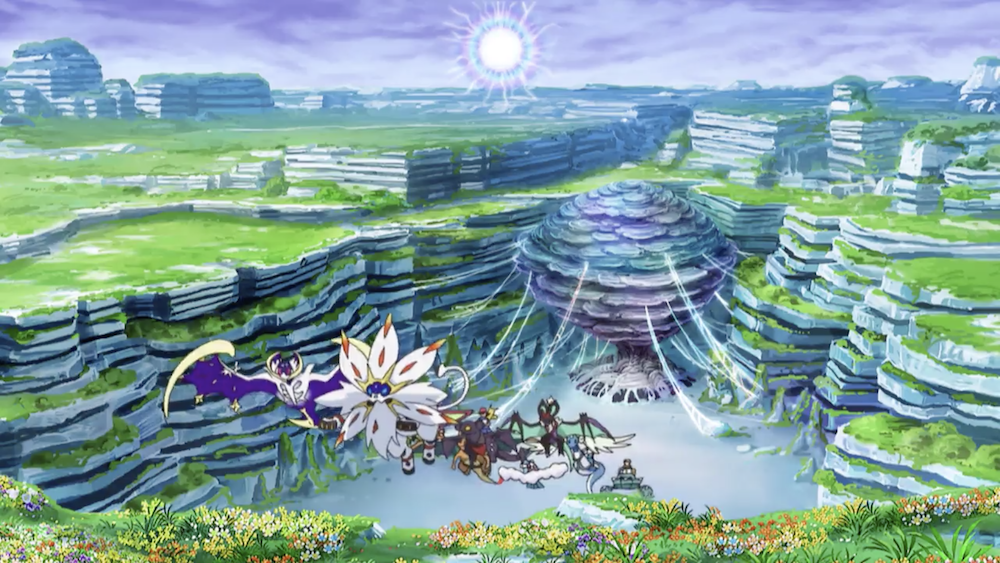
According to the artist Trial Captain, Mina, Ash’s Poipole’s drawings (particularly a lightning bolt symbol based on Pikachu’s tail) are an expression of its love for Ash and their “Alolan family.” What’s more, her Ribombee can supposedly sense Poipole’s emotions in its drawings. Now… this is something we should be cautious about hanging too much speculation on, because 1) communicating emotions is sort of the point of art, and 2) Mina is pretty consistently portrayed as, to put it nicely, a total cloud-cuckoo-lander. However, the episode’s dialogue does suggest that there’s something about Poipole’s drawings that only Ribombee can perceive, and all the other characters seem surprised and impressed at Mina’s assessment that Poipole can “draw its feelings.” Recall now that Poipole and Naganadel’s adhesive secretions are apparently their brain goo. To me, it’s… admittedly a stretch, but not a dramatic one, to suggest that the goo might have psychoactive properties – allowing Poipole to literally draw its feelings, imprinting a psychic impression of its mental state into its art. This isn’t something we see other Poipole do in the anime, and their nest isn’t decorated as we might expect it to be if they naturally used drawings to express their feelings, but then again, it also isn’t something that Ash’s Poipole needed to be taught to do; it just started spontaneously. Maybe all the Poipole back on the homeworld simply have no inspiration. Their world is dark, and slowly dying, without Necrozma’s light (the Ultra Recon Squad are absent from the anime, so some of their story and exposition is transferred to the Poipole colony); we eventually learn that Ash’s Poipole was sent to Alola specifically to find a way to get the light back. Poipole’s first drawings are of Pikachu, whose brilliant Thunderbolts it seems to find inspirational.

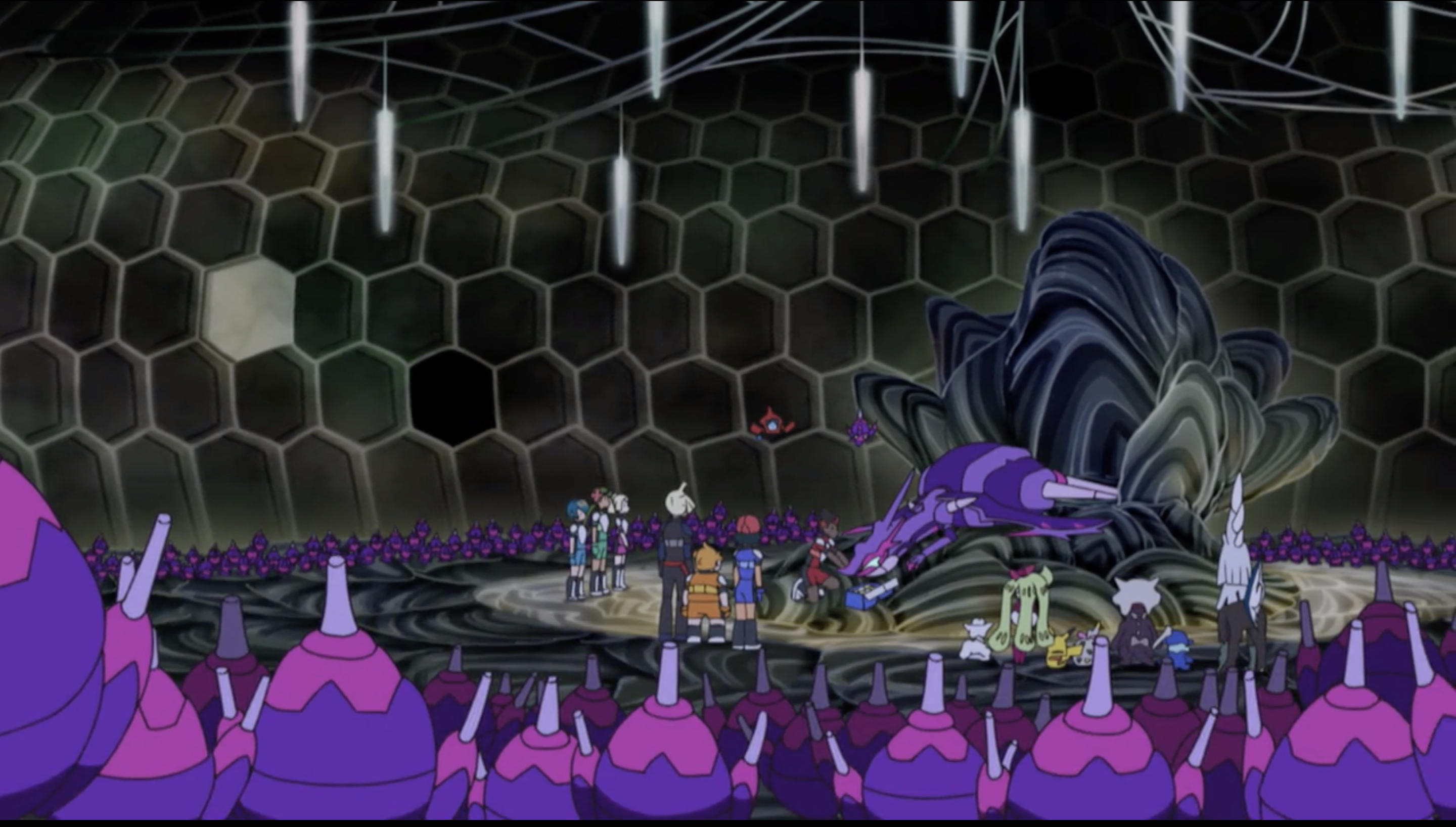
In battle, Naganadel is a mercifully straightforward Pokémon: it’s extremely fast, with lots of special attack power and passable defences. The Beast Boost ability can continue to raise either its special attack or its speed (depending on its nature) with every knockout it gets – and it even gets Nasty Plot, so you can have your cake and eat it, if you want. With luck (and a bit of strategic planning) it’s possible for Naganadel to just blow through an entire team, getting more and more dangerous as it goes, in much the same way as Nihilego, Kartana and Pheromosa can. Outside of really ridiculous legendary Pokémon, there’s not a lot that can reliably stop Naganadel once it gets going. Even Blissey, who basically exists to stall out special attackers, can’t beat a Nasty Plot Naganadel one-on-one without Ice Beam or Psychic, since it’s immune to Toxic and Blissey doesn’t really have a lot of other ways to cause actual harm. Normally, facing the prospect of getting nuked by Draco Meteor, the safe thing to do is switch in a Fairy-type, but against Naganadel this doesn’t really work since you risk being hit with a nasty Sludge Bomb or Sludge Wave instead. Steel Pokémon resist Draco Meteor and are immune to Poison attacks, but Naganadel can deal with most of them too, using Flamethrower or Fire Blast. It can learn Thunderbolt, Dark Pulse, Air Slash or Signal Beam as well, but honestly, if it ain’t broke, don’t fix it – one of Naganadel’s three core attacks will work better against almost anything. Thunderbolt wrecks Empoleon, one of the few Steel-types who won’t instantly fold to Fire Blast, and Dark Pulse can occasionally be punishing to Psychic-type switch-ins seeking to exploit Naganadel’s weakness, but that’s about it. Taking one of those moves is probably only worth considering if you’re building Naganadel to use a Choice Scarf or Choice Specs, and even then, U-Turn or even Dragon Pulse (as a more consistent alternative to Draco Meteor) is more likely to be useful.
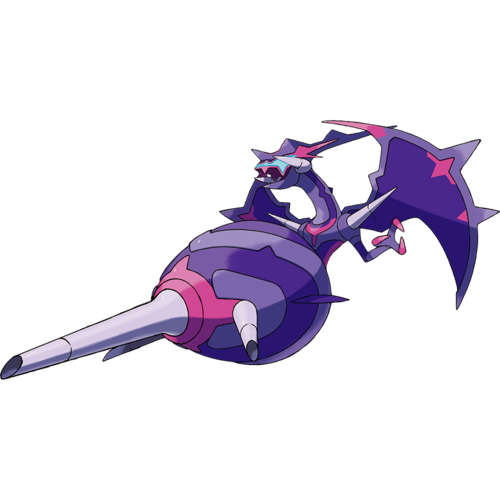
That’s… honestly about all there is to say; I know this section is normally longer, but Naganadel really does have a pretty clear optimal strategy (Nasty Plot, and make it fast enough that Beast Boost will trigger on its speed) with relatively few decent variations. You can choose to focus more heavily on its special attack, or give it a Choice item, or a Z-Crystal, but the broad strokes are going to be the same. Actually using it takes a bit of finesse, since Naganadel needs to accumulate stacks of Beast Boost to reach its true destructive potential; also, because it’s a snowball Pokémon, you should ideally try to eliminate anything on your opponent’s team that can stop it before you commit. Assuming you can do that, though, it’s one of the strongest Ultra Beasts, and a lot of fun to play with.
Poipole and Naganadel are… well, they’re really making me work, put it that way. There’s a lot of different elements going into the design, and although the Pokémon do look pretty cool, and everything seems like it relates to something else, I struggle a bit on what the overarching themes that tie it all together are supposed to be. I find myself, more than for any of the other Ultra Beasts so far, repeatedly asking “well, that’s neat, but why?” Maybe there’s something incredibly clever about it that I’m missing, but there’s a moment of comprehension, of suddenly being “in on the joke,” that most of the other Pokémon of generation VII have given me, and that Naganadel just hasn’t. This is, perhaps, a facet of the enjoyment of a Pokémon’s design that is peculiar to me and me alone, but it nonetheless leaves me strangely dissatisfied about this otherwise very fun Ultra Beast.

Check the title of this
LikeLiked by 2 people
Fixed!
LikeLike
I was 90% sure it was mostly just a bottle of glue, and didn’t realize that anyone wouldn’t be until reading this. Seriously, you’re overthinking it, but that’s kind of what we come here for so…
Chansey is the one who can’t hurt anything without Toxic or Seismic Toss (oh right, the Toss also works to 3-hit Naga unless you’ve invested in HP for some reason, and that’s probably enough when you’re not getting 3-hit back because you’re ****ing Eviolite Chansey); Blissey has a Special Attack that’s merely mediocre combined with no reason not to max out physical defense and special attack and call it a day. It also gets Ice Beam, which is equally effective against a Poison/Dragon like Naganadel, and Thunderbolt just for the famously wide neutral coverage. I run this set in Actual Diamond (stupid Telefang bootleg) so I know what I’m talking about.
LikeLike
He did mention, briefly, that Blissey couldn’t contest if she doesn’t carry Psychic, which kinda gets into what you’re talking about. Sure Ice Beam works too, but I think the point was more just to give a tangible example of Naganadel’s special attack power by exemplifying an anecdotal battle between them and a Blissey, who in most cases probably won’t be carrying either Psychic or Ice Beam.
LikeLike
^ This. The point was that Blissey can *hurt* it, sure, but if Naganadel already has one stack of Nasty Plot up, it can kill her faster than she can kill it unless she has a super-effective attack (not mentioning Ice Beam there was a mistake though; I’ll edit that in).
LikeLike
The problem is that if you’re using Blissey instead of Eviolite Chansey, you should probably be leaning in to what the former does better than the latter, which is having a Special Attack stat that isn’t completely embarrassing, in which case you’re probably using Bolt-Beam for near-perfect neutral coverage in only two moveslots and oh look that Naganadel is dead now.
LikeLike
I mean… we can debate what Blissey’s moveset should be all day if I ever do a Blissey review, but I’m not planning to any time soon.
EDIT: Okay in retrospect that was a bit dickish. The point is not to be a metagame analysis; the point is to illustrate in concrete and accessible terms just how nasty Naganadel’s special attacks are by comparison to the defensive capabilities of a well-known special wall. I didn’t say Chansey because Eviolite Chansey’s special defence is so ludicrous that wearing you down with Seismic Toss seems like an option unless Naganadel has two Nasty Plot stacks already (at which point, well, we’re all fµ¢£ed). I think it probably does come down to circumstance and player skill a bit (’cause Naganadel is faster and has some chance to kill her first by finishing with Draco Meteor if this isn’t a Chansey built for special defence, but maybe she’s used Softboiled, but maybe then you’ve had time for a second Nasty Plot, but then but then but then), making the example complicated enough that it’s not a useful illustration, or worth the time that it would take to examine all the angles in this article. With Blissey it’s more of a clear-cut “does she have a super-effective attack or doesn’t she,” and if she doesn’t she usually loses, which I think is a useful demonstration of how powerful Naganadel’s attacks are. Whether or not Blissey *should* have that attack, on whose team and in which metagame and supported by which EV spread, just isn’t really a question that I’m here for today.
LikeLiked by 1 person
So, sort of like how Porygon-Z can OHKO Blissey with Hyper Beam, but nobody cares because there are saner things you could be doing. (Other things that actually manage to kill Blissey targeting Special Defense include Water Spout Kyogre, which is also illustrative of the kind of power we’re talking about)
LikeLike
Pretty much, yeah. It’s not even something you’d recommend on Porygon-Z, but it’s kinda cool that it can even do that.
LikeLike
Re: bottle of glue interpretation, it makes *sense*, absolutely, but it doesn’t leave me any more satisfied, because what’s clever or interesting about that? It’s just a thing jammed together with another thing, and what does glue have to do with bees or dragons or whatever else Poipole is based on that makes those two things an interesting combination? There’s still just something missing here, for me.
LikeLike
You could say it’s gluing multiple ideas together and-
Okay I’m leaving I’m leaving
LikeLiked by 1 person
Oh, another thing: all the base stats of Ultra Beasts are prime numbers, as opposed to being divisible by 5 like nearly everything else’s. That’s “top percentage of Rattata” levels of meta shenanigans for dataminers to find amusing. (For the uninformed: Joey’s Rattata does in fact have ludicrously high IVs for something that wasn’t part of a eugenics program)
LikeLike
Yeah, that’s something I saw when researching this article for editing purposes. Interestingly enough, there is one exception: Naganadel’s speed is 121! I’m not sure if there is anything special about this though…
LikeLike
121 is prime; I will refuse to recognise the number 11 until the day I die
It knows what it did
LikeLike
I honestly think of Naganadel as the ‘hypodermic wasp’ because seriously, LOOK AT IT. I spent a lot of time in a trauma ball after evolving my Poipole because needle-related trauma is oh so fucking fun. Although ironically the little bundle of horrifying is helping me deal with said trauma because There Is No Such Thing As A Bad Pokemon.
LikeLike
As my name suggests, I am Not an Entomologist, so take this with a grain of salt. However, I believe there some kinds of bees whose stingers are heavily connected to their internal organs, to the extent that they sometimes (often, even?) leave behind critical organs like parts of their stomach or their lungs along with their stingers, and they die shortly after stinging.
While I don’t know of any cases when the associated organ happens to be the brain (I’m guessing that was just the most alien-sounding biological choice), I definitely believe that this is where Turner first got the idea for Naganadel’s brain to be in its abdomen, connected to its stinger, and to play up the sensitivity of its stingers.
If that’s the case, and that bit of flavor can be considered the center of the design, I think it helps to explain two major elements of Naganadel.
The first is why Naganadel is a special attacker despite its massive stingers. Obviously, if the sensitivity of its stingers really was among the first things decided about it, the idea to let it use them to fire attacks from afar and be a special attacker is simply a more logical choice than to make it something like Beedrill in the first place. I’m pretty sure no one has ever actually thought Naganadel ought to be a physical attacker from the rest of its design (which I’m assuming here was based on the need for it to look like a special attacker rather than vice versa, but I could be way off), but it’s worth noting where it might have come from anyway – I like trying to trace concepts back to the order they must have been conceived, so it’s interesting to me, at least.
But the second and more immediately interesting thing is where this puts Poipole. I honestly love this design choice: if Naganadel was conceived *first* as having its brain in its stinger, then Poipole’s whole schtick of turning upside-down and looking like an upside-down Naganadel is basically a way to put its brain back where we expect it to be, and it just flips the rest of the design with it. I think it works well because Poipole is the first form and not the second – it’s a clever bit of foreshadowing to build up to the eventual quirk of the line (and basically requires that Naganadel was designed first and Poipole was designed around it), and it makes both stages feel alien in different ways, gives Poipole a cute, quirky and distinctive movement and makes Naganadel’s brain stinger look like a satisfying, clever twist at the end even though it was probably the starting point of the entire concept all along.
Still salty that Poipole doesn’t evolve with the Inkay method, given that it’s probably one of the only opportunities we’ll ever have to use that again…
As an aside, I know it’s a stupid explanation, but I also want very badly to believe that the idea of a Poison/Dragon bee (with Shiny colors that distinctly resemble Mega Beedrill, as if its base form didn’t already, if only by virtue of their shared basis and shared needle emphasis) was at least *partially* a playful jab at Bulbapedia. Remember when they mistranslated the CoroCoro leaks in October of 2014 and got the types of the new Megas wrong? Those Megas were Mega Pidgeot, which they declared Electric/Flying… and Mega Beedrill, which they declared Poison/Dragon. It’s not even completely implausible, because James Turner is the one who designed the line, and he happens to be the one native English speaker whom I know designs Pokémon – if anyone *were* to make such a reference, it would have to be him, and lo and behold…
Still not sure where the glue thing comes from, but maybe that sheds some light on how some of the rest of it fits together?
LikeLike
As I was reading your comment, all I could think was, “But Inkay already did the whole flip over evolution, do we need another? Why doesn’t this one evolve the same way?” And then you addressed that yourself so bravo!
I mean, I’d say your theory makes sense, I don’t disagree with this possibility. I do wish it evolved the same way then, simply for consistency… but it does look like it flips over, regardless of how it evolves in game. There are indeed no actual bees with brains connected to their stingers (I’m not an entomologist either but, despite my username, I’m a librarian by trade so researching all sorts of stuff is my specialty – linguistics is an interest and was my intended trajectory during the late years of my undergrad), but otherwise you are correct about bees and it’s a valid connection, I won’t dispute that. The adhesive venom remains a mystery, but heck, there are a few Pokémon designs that are even more haphazard, I can accept it just being a random trait they threw it to increase the weirdness.
LikeLike
I personally thought the adhesive venom shtick was based on the hunting spray of velvet worms or the sticky venom webbing that spitting spiders shoot when capturing prey. There are some species of wasp including the infamous Japanese giant hornet which can also spray venom from their stingers too, so combine the two and you get a heck of an interesting biochemical weapon that sounds simultaneously plausible and fantastical.
I never did realize the upside-down deal either until just now, and I third the notion that Poipole should’ve evolved in the same way as Inkay, but of course Game Freak wouldn’t give the world the satisfaction. In truth, though, I just wish we got more Ultra Beasts that evolved rather than almost every single one being a single-stager. I feel like it’d add some more variety to the roster than just a bunch of unrelated designs listed together.
LikeLike